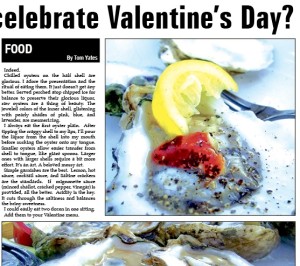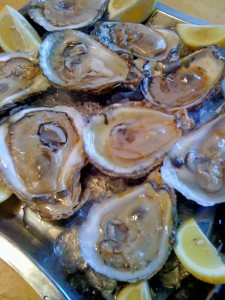How to Celebrate Valentine’s Day?
Addicted To Love
BY TOM YATES
 Chocolate is probably the food most associate with love. It contains both a sedative that lowers inhibitions and a stimulant that increases desire for physical contact.
Chocolate is probably the food most associate with love. It contains both a sedative that lowers inhibitions and a stimulant that increases desire for physical contact.
Researchers studying chocolate have found it to contain phenylethylamine and serotonin, which are both “feel good” chemicals that occur naturally in our bodies and are released by our brains when we are happy or feeling loving or passionate. [Discovery Health]
There are other foods with aphrodisiacal qualities. Caviar. Although sexy on its own, caviar is high in zinc, which raises the levels of testosterone in men. Caviar’s salty snap feels sensual on the tongue and is an ideal pairing with chilled bubbly champagne, considered the drink of love. Double love punch.
Asparagus. Asparagus is a great source of potassium, fiber, vitamin B6, A, C, thiamin, and folic acid. In 19th century France, bridegrooms were served three courses of asparagus during their prenuptial dinners.

Oysters. Oysters, the quintessential love food.. If oysters are the gold standard of aphrodisiacal food, consider me an addict. I love raw oysters. Yesterday, I counted 15 photographs (on my phone) of 15 chilled oyster platters from 15 different Lexington restaurants. Further evidence that whenever they appear on restaurant menus, I order them. Period. I don’t devour them for their aphrodisiacal qualities (not on purpose, anyway), I simply love their briny sweet taste of the ocean. A lot has been written about oysters and what they taste like. Depending on seasonality, location, and water temperature, some say they offer hints of melon and cucumber. M.F.K. Fisher, prolific food writer and author of Consider The Oyster says they “…are more like the smell of rock pools at low tide than any other food in the world.” French poet, Leon-Paul Farque says eating one is “..like kissing the sea on the lips.”
Indeed.
Chilled oysters on the half shell are glorious. I adore the presentation and the ritual of eating them. It just doesn’t get any better. Served perched atop chipped ice for balance to preserve their glorious liquor, raw oysters are a thing of beauty. The jeweled colors of the inner shell, glistening with pearly shades of pink, blue, and lavender, are mesmerizing.
I always eat the first oyster plain. After tipping the craggy shell to my lips, I’ll pour the liquor from the shell into my mouth before sucking the oyster onto my tongue. Smaller oysters allow easier transfer from shell to tongue, like giant spoons. Larger ones with larger shells require a bit more effort. It’s an art. A beloved messy art.
Simple garnishes are the best. Lemon, hot sauce, cocktail sauce, and Saltine crackers are the standards. If mignonette sauce (minced shallot, cracked pepper, vinegar) is provided, all the better. Acidity is the key. It cuts through the saltiness and balances the briny sweetness.
I could easily eat two dozen in one sitting.
Add them to your Valentine menu.
This article originally appears on page 13 of the February 2015 printed issue of Ace.
Subscribe to the Ace e-dition for Lexington news, arts, culture, and entertainment, delivered to your inbox every Thursday morning.








